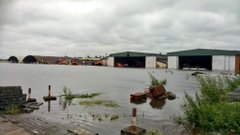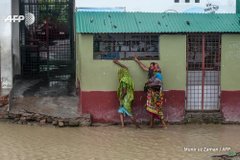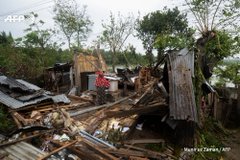Updated May. 22, 2020 1:35 PM
Cyclone Amphan, one of the strongest storms in recent memory to churn through the Bay of Bengal, turned deadly after roaring ashore in northeastern India Wednesday afternoon local time with the force equivalent to a Category 3 hurricane.
The India Meteorological Department (IMD) said the storm, rated as an extremely severe cyclonic storm, made landfall between the hours of 3:30 p.m. and 5:30 p.m. local time along the shores of the Indian state of West Bengal near the Sunderbans. Millions of residents from northeastern India to Bangladesh, many of whom live in low-lying areas, were evacuated ahead of the storm's arrival, despite ongoing COVID-19 lockdowns in both countries.
The number of fatalities continued to climb following the cyclone's landfall. On Thursday afternoon, local time, the Chief Minister of West Bengal, Mamata Banerjee, informed the public that at least 72 deaths in the area were being attributed to the effects dangerous cyclone, according to Asian News International.
“Area after area has been devastated. Communications are disrupted,” Banerjee told Reuters.
Banerjee expressed concern for the city of Kolkata, saying the devastation the cyclone left in the city was "a disaster bigger than COVID-19".
On Friday, India's prime minister, Narendra Modi, traveled to Odisha and and then to West Bengal to
Modi announced on Friday that $132 million in relief
BBC reported that at least 12 people in Bangladesh were killed as the cyclone hit. AFP reported that Bangladesh officials confirmed that the deaths included a 5-year-old boy and 75-year-old man who were struck by falling trees. Another victim was an emergency volunteer who drowned.
One resident in the Sunderbans' Ghoramara Island told Reuters by phone that the storm had damaged numerous houses. The Times of India said over 5,500 homes were damaged.
People walk past a tree branch fallen in the middle of a road after Cyclone Amphan hit the region in Kolkata, India, Thursday, May 21, 2020. A powerful cyclone ripped through densely populated coastal India and Bangladesh, blowing off roofs and whipping up waves that swallowed embankments and bridges and left entire villages without
Amphan had weakened a bit prior to landfall, but it still packed a significant punch. Its maximum sustained winds were around 155-165 km/h (96-102 mph) and gusts reached 185 km/h (114 mph) as it blasted coastal areas Wednesday. Wind-whipped rain lashed the West Bengal capital of Kolkata. Streets were waterlogged throughout the city after more than 3 inches of rain fell, and there were reports of damage to buildings, the Times of India said.
Significant damage was reported at the airport in Kolkata, closing it temporarily. Flights resumed at the airport on Thursday afternoon.
The AFP reported that millions of people were still without power on Thursday.
"Thousands of mud huts have been leveled, trees uprooted, roads washed away and crops destroyed," Banerjee said.
Across the Sunderbans, swampy islands ahead of the mainland of India and Bangladesh, also took a direct hit. The extent of the destruction in this area, has been slow to emerge after being cut off following the storm, BBC reported.
In Bangladesh, it is feared that tens of thousands of homes were destroyed by the cyclone, with some villages totally submerged in water.
Several dams in Bangladesh were broken or cracked at a minimum of 64 points across 13 districts, according to the Daily Ittefaq.
The Dhaka Tribune reports that the city of Koyra was left exposed, with water flowing through the streets, as the dam protecting the town broke in 11 places. Amphan heavy rainfall and strong winds are being attributed to nearby river rises and overflow that lead to the dam breakage.
Due to the strength of the cyclone and extreme risk to lives and property, Amphan was rated a 4 on the AccuWeather RealImpact™ Scale for Tropical Cyclones.
After slowly
Amphan became a super cyclonic storm on Monday night local time, the highest level on India's tropical cyclone scale, and was producing winds around 220 km/h (173 mph). According to AccuWeather Lead International Forecaster Jason Nicholls, Amphan was the first super cyclonic storm in the Bay of Bengal since the 1999 Odisha Cyclone. That cyclone in 1999 produced winds up to 260 km/h (160 mph).
CLICK HERE FOR THE FREE ACCUWEATHER APP
The region has been hit by some of the most devastating cyclones in the world, in part due to similar factors compounding the dangers with Amphan, including the shape of the coastline and low elevation. The 'Great Cyclone Bhola' that struck in November of 1970 is estimated to have killed between 300,000 and 500,000 people in West Bengal in India and what is now Bangladesh but was then East Pakistan, according to the World Meteorological Organization. Nearly 50 years later, Bhola still stands as the deadliest cyclone in the world.
Just over 20 years later, the 1991 Bangladesh Cyclone led to more than 138,866 fatalities and is the fifth deadliest tropical cyclone in world history.
Due to the shape of the coast and its low-lying elevation, storm surge can be a particularly deadly threat from tropical cyclones. Much of that area is barely above sea level, making it prone to disastrous flooding. Adding to the low elevation is the shape of the coastline. Since the coastline is concave, storm surge caused by cyclones can be especially destructive.

Amphan seen making landfall along northeastern India on May 20, 2020. (Photo / CIRA / RAAMB)
Complicating matters further is the ongoing COVID-19 crisis. There are over 106,000 confirmed cases of COVID-19 in India, while Bangladesh has reported more than 26,700, according to data from Johns Hopkins University.
"The impact of Amphan is worse than coronavirus," Mamata Banerjee, chief minister of West Bengal, said to local media, according to AFP.
Reuters reported that officials in West Bengal and the neighboring state of Odisha were struggling to house evacuees because many shelters were set up for coronavirus quarantine centers. Others had to be forced from their homes because they were afraid of catching the virus.
“We have literally had to force people out of their homes, make them wear masks and put them in government buildings,” a senior police official in Kolkata told Reuters.
RELATED:
The evacuations in Bangladesh could rival the record number set this past fall when Cyclone Bulbul took aim at the country, according to the World Meteorological Organization (WMO).
Ahead of the storm, the WMO said United Nations humanitarian agencies "stepped up preparations in the Rohingya settlements of Cox’s Bazar, home to approximately 1.2 million refugees and host community members."
Officials with the International Organization for Migration were concerned there could be a new humanitarian crisis in the region due to the cyclone's timing with the COVID-19 outbreak.
“Communities are already vulnerable to the devastating health crisis and we know that if people are forced to seek communal shelter, they will be unable to maintain physical distancing and run the risk of contracting or transmitting the disease," said Manuel Pereira, Deputy Chief of Mission for IOM Bangladesh.
Keep checking back on AccuWeather.com and stay tuned to the AccuWeather Network on DirecTV, Frontier and Verizon Fios.






 Munir uz Zaman
Munir uz Zaman


No comments:
Post a Comment